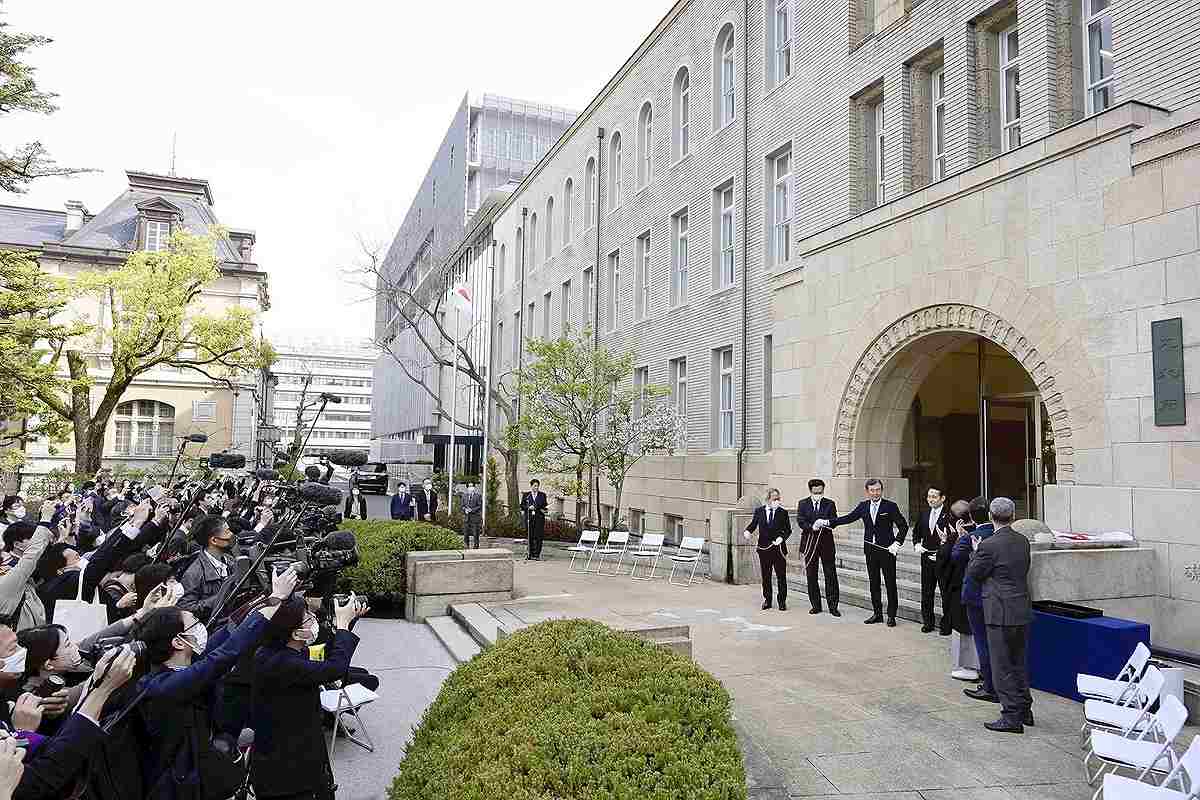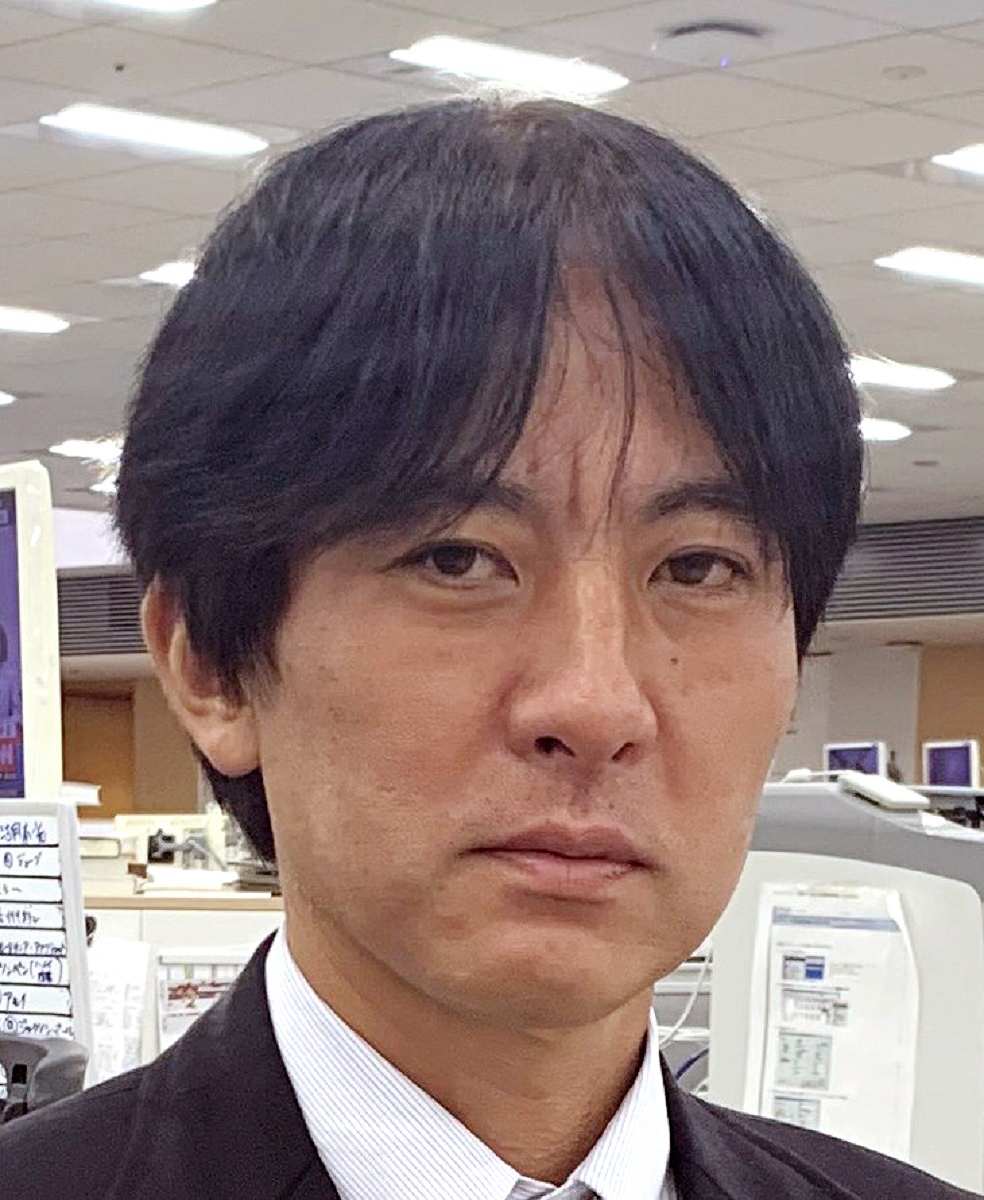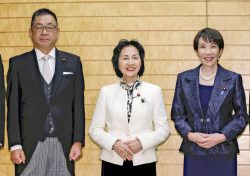
The Cultural Affairs Agency has been relocated to Kyoto from Tokyo. A ceremony was held in front of the new office building in Kyoto on March 28.
8:00 JST, December 23, 2023
Kyoto, a city with more than 1,200 years of history and tradition, is now entering a period of change. As the global coronavirus pandemic subsides and inbound tourism to Japan rapidly recovers, the biggest challenge is how to strike a balance between maintaining traditions inside Kyoto and sharing information about them internationally. Another challenge is how Kyoto can achieve further development. Many people in Japan, and around the world, are closely watching the future of this fascinating city.
The Kansai region is home to 50% of Japan’s national treasures and 40% of its important cultural properties. Kyoto in particular has numerous temples and shrines, including the World Heritage Kiyomizudera Temple, as well as traditional crafts such as Nishijin textiles. Traditional events such as the Gion Festival are held throughout the year. No one doubts that Kyoto is one of the most popular travel destinations for foreigners. If you walk around the city, you can see many foreigners taking in the historic atmosphere.
I think Kyoto has three major issues at this moment. The first is maintaining and passing on its traditional culture. That is the fate of a historic city. Second is the growth of inbound tourism. The last one is its dwindling population, which must be taken more and more seriously in the near future.
Maintaining and passing on Kyoto’s traditional culture is the biggest mission that Japan’s government, Kyoto Prefecture, Kyoto City and other entities have been working on. A major recent step was the relocation of the central government’s Cultural Affairs Agency from Tokyo to Kyoto in March. This is the first time that a central government office has been relocated to outside Tokyo since the Meiji era (1868-1912), when Japan’s first system of constitutional government was established. The relocation is also part of the regional revitalization agenda that was advocated by former Prime Minister Shinzo Abe, who called for reducing the concentration of power in one area of the country.
Former House of Representatives Speaker Bunmei Ibuki, who was elected from Kyoto, is said to have convinced Abe that “relocating the Cultural Affairs Agency to Kyoto, where the spirit of mutual aid and cooperation of the Japanese people still remains, will fulfill your call for a ‘beautiful country.’” Whether the relocation will be an important part of Abe’s legacy will depend on how the agency functions in Kyoto.
What will change with the relocation? Facilities for the restoration of cultural properties will be established in Kyoto by 2030 to promote the protection of cultural properties and the promotion of the arts. The agency will consolidate information on restoration projects in various parts of Japan and share know-how. It will also develop mechanisms to leverage Kyoto’s “brand” to dramatically increase its ability to spread information on culture and art.
It is also necessary to train successors for maintaining and passing on Kyoto culture. The agency must secure a proper budget for this purpose and support the passing on of artisans’ skills. The bearers of traditional culture are aging. There is no time to wait.
In terms of spreading information, it is essential to create a trend to actively export not only traditional culture but also manga, anime and music, which are among Japan’s strong points, to the rest of the world. In an exclusive interview with The Yomiuri Shimbun, Cultural Affairs Agency Commissioner Shunichi Tokura said: “We should have more confidence in Japan’s brand power to attract inbound tourists. We should make culture and the arts a key industry for export.” It is hoped that concrete measures will be presented as soon as possible and that they will start to be realized.
Looking at inbound tourism in Kyoto, you can see a contrast between light and shadow. The occupancy rate of major hotels in Kyoto in October 2023 was 82.9%, almost the same level as the same month in 2019, before the coronavirus pandemic. It is certain that foreign tourists have made a great contribution to that recovery. It is vital to further invigorate Kyoto’s economy by attracting more foreign visitors. On the other hand, the negative effects of overtourism include local people being unable to easily take buses as they go about their day because the buses are crammed with foreign tourists. It is quite serious that overtourism is impacting the lives of citizens, which may worsen the feelings of citizens toward foreigners. Urgent action is needed to resolve the situation.
Restrictions on entry to temples and shrines and price hikes related to the tourism industry may have a certain effect in lessening the number of foreign tourists, but at the same time, domestic tourists will also be affected. There is a growing trend of specializing in services for the wealthy, but if ordinary tourists cannot enjoy these services, Kyoto’s appeal will be undermined.
What can rein in overtourism? One recent initiative that deserves attention is the decentralization of tourism from the center of Kyoto to the periphery. Kyoto Station and other locations have begun offering storage for tourists’ big suitcases so they can go sightseeing without hauling their luggage along, thereby freeing up space for local people on public transportation. While it remains to be seen whether those efforts will work, all Kyoto can do is continue a process of trial and error to find better ways to please tourists and locals alike.
Although inbound tourism is increasing, the population of Kyoto City is on a downward trend. The city’s population as of Dec. 1, 2023, was approximately 1.442 million. It is roughly 20,000 people less than the same month in 2020. This is believed to be the result of an exodus of young people to the suburbs due to soaring land prices caused by a rush to build hotels and other factors.
The city of Kyoto has taken measures such as improving “new towns” — large-scale housing developments that are now long past being new, and where there has been little generational turnover — to make them more livable for young people, but it remains to be seen what effect this will have. If Kyoto does not attract people who can be expected to settle and support the city’s development, it may become a “hollowed-out city,” meaning that only tourists will actually stay in Kyoto and those who work in the city will merely commute there. Kyoto should be attractive not only to tourists but also to local people who want to settle in.
Next February, Kyoto will hold a mayoral election. Daisaku Kadokawa, who has been mayor since 2008, is not seeking another term, making it the first time in 16 years that multiple newcomers will face off. Kyoto voters must be interested in the vision of their next mayor, especially in terms of how to maintain and pass on Kyoto’s traditions in such difficult circumstances. How will a new mayor support Kyoto in its period of change? Each candidate will be tested on his ability and degree of seriousness toward a future for Kyoto that pays respect to its past.
Political Pulse appears every Saturday.

Norimasa Tahara
Norimasa Tahara is an editor in the editorial bureau of The Yomiuri Shimbun Osaka.
"Editorial & Columns" POPULAR ARTICLE
-

Violations of Subcontract Law: Major Automakers Must Eliminate Old Practices
-

Local Governments’ Tax Revenues: Devise Ways to Correct Imbalances in Tax Sources
-

5 Japanese Business Dinner Mistakes to Avoid — and What They Taught Me About Business in Japan
-

Heavy Rains in Asia: Support for Victims, Flood-Control Measures Urgently Needed
-

Rice Coupons: A Misguided Approach to Countering Rising Prices
JN ACCESS RANKING
-

Keidanren Chairman Yoshinobu Tsutsui Visits Kashiwazaki-Kariwa Nuclear Power Plant; Inspects New Emergency Safety System
-

Imports of Rare Earths from China Facing Delays, May Be Caused by Deterioration of Japan-China Relations
-

University of Tokyo Professor Discusses Japanese Economic Security in Interview Ahead of Forum
-

Japan Pulls out of Vietnam Nuclear Project, Complicating Hanoi’s Power Plans
-

Govt Aims to Expand NISA Program Lineup, Abolish Age Restriction

























